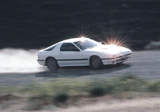
Style, driving performance, and comfort - “New Adult Sport” concept
In October 1985, seven years after the launch of the original Savanna RX-7, the fully redesigned second generation model, the FC-series RX-7, was introduced. The development team wanted to build a sports car to surpass Porsche. They aimed for "the perfect sports car that exists within everyone's heart - a sports car for a liberated adult." It reflected the climate of the day that valued emotional satisfaction as well as material pleasures, while responding to demand from more mature drivers for comfort as well as style and performance.
The new RX-7 was more upmarket than its predecessor, with higher quality levels and a flowing and dynamic design. The 13B engine featured an air cooled twin scroll turbocharger that provided exceptional performance feel throughout the engine speed range. The independent rear suspension was specially developed for optimal handling and stability when cornering. The chassis design passed the notoriously strict West German patent examination and cemented Mazda's reputation for engineering excellence among the global automakers.
A pure sports car with rotary power
The third generation, FD-series RX-7 was launched in 1991. It was named Anfini RX-7, after one of Mazda's five sales channels that operated in Japan at that time. To advance from the second generation model, the development team aimed to return to the origin of the sports car. As well as substantially boosting power output, the team worked to slash weight under a strategy called Plan Zero. The engineer in charge of each component posted their ideas on a notice board, and thanks to this sharing of knowledge, over 100 kilograms were removed from the bodyweight.
With a design theme of "Beauty in the Beast," the new model was given glamorous front fenders. In order to enhance dynamic stability, the overall length, height and wheelbase were made more compact, while the vehicle width was increased. Despite making the powertrain 18 kilograms lighter, the team used their experience from competing at Le Mans to boost power by 50 ps. As a result of these tireless efforts, the new RX-7 engineers achieved their target weight-to-power ratio of less than five kilograms per ps. The Anfini RX-7 won the 1991 RJC New Car of the Year award.
Over the course of its three generations, the RX-7 secured its place in the history of sports cars. Throughout its lifetime, the development team continued to improve performance and never gave up the pursuit of the perfect sports car. In the North American IMSA racing series the RX-7 achieved an unprecedented 100 victories, cementing its place in the record books. Production of the RX-7 came to an end in 2002 with the introduction of stricter emissions regulations. However, even today, it remains a common sight at racetracks, and pleas to introduce a new version are louder than ever.

Second-generation Savanna RX-7


